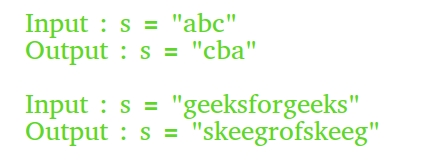Different Methods to Reverse a String in C++
Last Updated :
23 Sep, 2023
The reversing of a string is nothing but simply substituting the last element of a string to the 1st position of the string.

Different Methods to Reverse a String in C++ are:
- Making our own reverse function
- Using ‘inbuilt’ reverse function
- Using Constructor
- Using a temp file
1. Making a Custom Reverse Function For Swapping Characters
- Using a first to last approach ‘for’ loop
CPP
#include <bits/stdc++.h>
using namespace std;
void reverseStr(string& str)
{
int n = str.length();
for (int i = 0; i < n / 2; i++)
swap(str[i], str[n - i - 1]);
}
int main()
{
string str = "geeksforgeeks";
reverseStr(str);
cout << str;
return 0;
}
|
Complexity Analysis:
Time Complexity: O(N)
Auxiliary Space: O(1)
- Using a first to last Approach with while loop
C++
#include <bits/stdc++.h>
using namespace std;
void reverseStr(string& str)
{
int len = str.length();
int n = len-1;
int i = 0;
while(i<=n){
swap(str[i],str[n]);
n = n-1;
i = i+1;
}
}
int main()
{
string str = "geeksforgeeks";
reverseStr(str);
cout << str;
return 0;
}
|
Complexity Analysis:
Time Complexity: O(N)
Auxiliary Space: O(1)
- Using a Last to First Approach ‘for‘ Loop
C++
#include <bits/stdc++.h>
using namespace std;
void reverse(string str)
{
for (int i = str.length() - 1; i >= 0; i--)
cout << str[i];
}
int main(void)
{
string s = "GeeksforGeeks";
reverse(s);
return (0);
}
|
Complexity Analysis:
Time Complexity: O(N)
Auxiliary Space: O(1)
- Using a Last to First Approach ‘while’ Loop
C++
#include <bits/stdc++.h>
using namespace std;
void reverse(string str)
{
int len = str.length();
int n = len;
while(n--)
cout << str[n];
}
int main(void)
{
string s = "GeeksforGeeks";
reverse(s);
return (0);
}
|
Complexity Analysis:
Time Complexity: O(N)
Auxiliary Space: O(1)
1. Using recursion Function with two pointer approach
Recursion functions are used for iterating to different indexes of the string.
C++
#include <bits/stdc++.h>
using namespace std;
void reverseStr(string& str, int n, int i)
{
if(n<=i){return;}
swap(str[i],str[n]);
reverseStr(str,n-1,i+1);
}
int main()
{
string str = "geeksforgeeks";
reverseStr(str, str.length()-1, 0);
cout << str;
return 0;
}
|
Complexity Analysis:
Time Complexity: O(N)
Auxiliary Space: O(N)
2. Using one pointer approach in recursion
Below is the implementation of the code:
C++
#include <iostream>
using namespace std;
void getreverse(string &str, int i)
{
if (i > (str.length() - 1 - i))
{
return;
}
swap(str[i], str[str.length() - i - 1]);
i++;
getreverse(str, i);
}
int main()
{
string name = "geeksforgeeks";
getreverse(name, 0);
cout << name << endl;
return 0;
}
|
Complexity Analysis:
Time Complexity: O(N)
Auxiliary Space: O(N)
3. Using the inbuilt “reverse” Function
There is a direct function in the “algorithm” header file for doing reverse that saves our time when programming.
// Reverses elements in [begin, end]
void reverse (BidirectionalIterator begin,
BidirectionalIterator end);
CPP
#include <bits/stdc++.h>
using namespace std;
int main()
{
string str = "geeksforgeeks";
reverse(str.begin(), str.end());
cout << str;
return 0;
}
|
Complexity Analysis:
Time Complexity: O(N)
Auxiliary Space: O(1)
4. Reverse a String Using the Constructor
Passing reverse iterators to the constructor returns us a reversed string.
CPP
#include <bits/stdc++.h>
using namespace std;
int main()
{
string str = "GeeksforGeeks";
string rev = string(str.rbegin(), str.rend());
cout << rev << endl;
return 0;
}
|
Complexity Analysis:
Time Complexity: O(N)
Auxiliary Space: O(1)
5. Using a Temporary String
CPP
#include <bits/stdc++.h>
using namespace std;
int main()
{
string str = "GeeksforGeeks";
int n = str.length();
string rev;
for (int i = n - 1; i >= 0; i--)
rev.push_back(str[i]);
cout << rev << endl;
return 0;
}
|
Complexity Analysis:
Time Complexity: O(N)
Auxiliary Space: O(1)
How could we get the reverse of a const string?
To get the reverse of a const string we have to first declare a ‘const string’ in a user-defined function following which we have declared then use the following algorithm for the calling of the desired objects.
“const reverseConstString = function(string) { return string.split("").reverse().join("")”
Example:
C++
#include <bits/stdc++.h>
using namespace std;
char* reverseConstString(char const* str)
{
int n = strlen(str);
char* rev = new char[n + 1];
strcpy(rev, str);
for (int i = 0, j = n - 1; i < j; i++, j--)
swap(rev[i], rev[j]);
return rev;
}
int main(void)
{
const char* s = "GeeksforGeeks";
printf("%s", reverseConstString(s));
return (0);
}
|
Time Complexity: O(N)
Auxiliary Space: O(N)
Using Stack Data Structure
C++
#include <bits/stdc++.h>
using namespace std;
int main()
{
string s = "GeeksforGeeks";
stack<char> st;
for (char x : s)
st.push(x);
while (!st.empty()) {
cout << st.top();
st.pop();
}
return 0;
}
|
Complexity Analysis:
Time Complexity: O(N)
Auxiliary Space: O(N)
Using Vector Data Structure
C++
#include <bits/stdc++.h>
using namespace std;
int main()
{
string s = "GeeksforGeeks";
int n=s.length();
vector<char> vec;
for (int i = n - 1; i >= 0; i--)
vec.push_back(s[i]);
for(auto i:vec){
cout<<i;
}
return 0;
}
|
Complexity Analysis:
Time Complexity: O(N)
Auxiliary Space: O(N)
This article is contributed by Priyam kakati, Ranju Kumari, Somesh Awasthi.
Like Article
Suggest improvement
Share your thoughts in the comments
Please Login to comment...